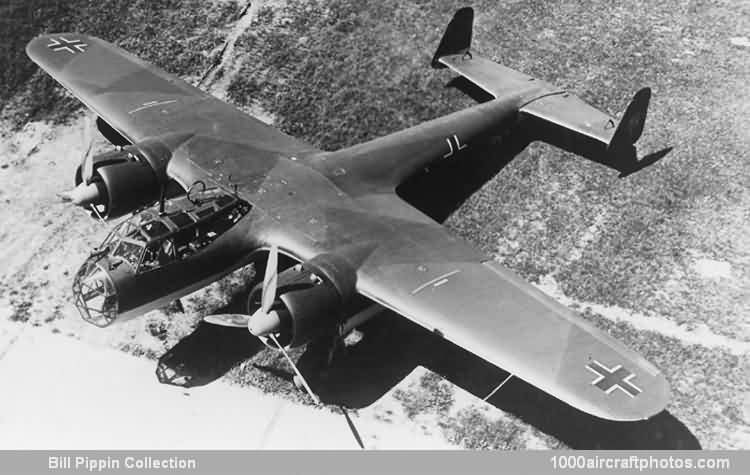11/30/2012. Remarks by Johan Visschedijk: "The last and most important production model of the Do 17 was the Do 17 Z which appeared from early 1939 onwards. Essentially similar to the Do 17 S-0, the Do 17 Z was powered by two Bramo 323A nine-cylinder radial engines. The Do 17 Z-0 pre-production and Do 17 Z-1 production aircraft were identical, but were soon superseded by the Do 17 Z-2.
This machine was powered by two 1,000 hp Bramo 232P radials with two-stage superchargers. Armament was increased to six 0.311 in (7.9 mm) MG 15 machine guns, one fixed and one movable firing forward, one firing aft in the dorsal position, one firing aft in the ventral position and two mounted in the side windows. Maximum bomb load was 2,205 lb (1,000 kg) and provision was made for a fifth crew member.
The Do 17 Z-3 was a long-range photo-reconnaissance variant with two Rb 20/30 cameras fitted in the entrance door position, 22 of these aircraft being produced. The Do 17 Z-4 was a dual-control trainer version and the Z-5 was similar but carried special inflatable floatation bags and additional survival equipment.
Following early night bombing attacks by the RAF and the establishment of the Luftwaffe night fighter arm, consideration was given to a night fighter version of the Do 17. The nose section of a Do 17 Z-3 was replaced by the nose of a Ju 88 C-1 fighter. The forward part of the Junkers aircraft was virtually identical in cross-section to that of the Do 17. It contained three 0.311 in (7.9 mm) MG 17 machine guns and one 0.787 in (20 mm) MG FF cannon. The modification was designated Do 17 Z-6 "Kauz I" (Screech Owl I) but the marriage of the two aircraft was not very successful.
Accordingly, a second variant with an entirely new nose was developed. Designated Do 17 Z-10 "Kauz II", the new machine carried four MG 17 machine guns in the upper part of the nose, with two 0.787 in (20 mm) MG FF cannon contained in the lower part. The breeches of the cannon were positioned in the crew compartment and it was possible to reload them in flight. Rear defense was confined to one 0.311 in (7.9 mm) MG 15 machine gun.
The Do 17 Z-10 was also fitted with a special infra-red spotlight known as "Spanner Anlage". This was used in conjunction with a "Q-Rohr" sighting screen and the standard Revi C 12/D gunsight. The "Spanner Anlage" was too sensitive, picking up a multitude of other sightings besides that of an enemy bomber, and was soon replaced by an early version of the Lichtenstein SN 2 radar. Only nine Do 17 Z-10 night fighters were completed, these being delivered to I./NJG 2 late in 1940. They proved inferior to the unit's major equipment, the Ju 88 C, and were soon replaced by the Junkers product."
